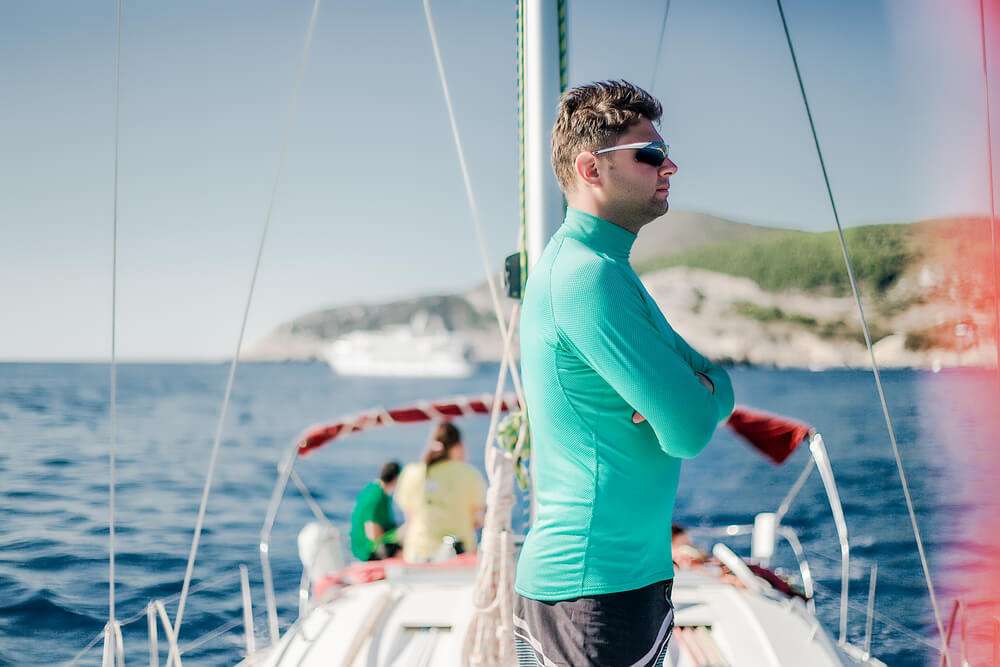How to Incorporate UPF Clothing Into Your Active Lifestyle: A Guide for Outdoor Enthusiasts


Incorporating UPF clothing into an active lifestyle offers a practical solution for those seeking effective sun protection while engaging in outdoor activities.
UPF, which stands for Ultraviolet Protection Factor, is a rating system used for apparel that indicates how well a fabric can protect the skin from harmful UV rays. Clothing with a UPF rating of 50+, for example, allows less than 2% of UV radiation to pass through, effectively shielding skin from over 98% of UVA and UVB rays.
Active individuals are increasingly turning to UPF-rated garments as a reliable form of sun defense that complements the use of sunscreen. Unlike sunscreen, which requires regular reapplication,
UPF clothing provides consistent protection as long as it's worn, making it a convenient option for long periods spent outdoors. Sun-protective clothing can range from lightweight shirts to full-length pants and hats and comes in various styles suited to different sports and activities.
At Rayward Apparel, we understand that choosing the right UPF clothing involves several important factors. These include the type of fabric, how tightly it's woven, and even the color, as these factors impact the level of sun protection provided.
While traditionally, dark and tightly woven fabrics offered the best protection, today's textile advancements have allowed us to create sun-safe clothing that's not only protective but also breathable and moisture-wicking. This means you can stay comfortable and safe, making it ideal for active individuals. Contact Rayward Apparel today for more information and to explore our selection.
Understanding UPF and Its Importance
Ultraviolet Protection Factor (UPF) is a rating system specifically for clothing that measures the level of sun protection that the fabric provides to the skin. Similar to Sun Protection Factor (SPF) for sunscreens, the higher the UPF number, the greater the degree of UV ray protection offered.
UPF clothing utilizes various methods to shield the skin:
- Tight Weaves: Reduces the space between fibers, limiting UV penetration.
- Specialized Dyes: Enhance the garment’s capacity to absorb UV rays.
- Treated Fabrics: Undergo chemical processes to improve UV blocking.
A high UPF rating indicates that a minimal amount of UV radiation passes through the fabric. For example, a shirt with a rating of UPF 50 allows only 1/50th of the sun’s UV rays to reach the skin. When integrated into an active lifestyle, UPF clothing serves as a durable line of defense against harmful UV rays, which can lead to skin damage and an increased risk of skin cancer.
UPF clothing is particularly beneficial because:
- Effectiveness: It blocks a significant portion of UV radiation, which may not be entirely prevented by sunscreen alone.
- Convenience: It provides continuous protection without the need for reapplication.
- Long-term savings: It may reduce the need for frequent sunscreen purchases and can be a cost-effective alternative in the long run.
Incorporating UPF-rated fabrics into an active wardrobe is a smart, practical method to ensure consistent sun protection during outdoor activities.
Selecting the Right UPF Clothing
When considering UPF clothing, individuals should focus on the materials and fabrication for maximum protection, as well as understand the significance of UPF ratings to choose the best clothing for their lifestyle.
Materials and Fabric Weave
The effectiveness of UPF clothing is largely determined by the materials and the tightness of the fabric weave.
- Denser fabrics, like nylon or polyester, provide greater UV protection than thinner materials.
- A tight weave contributes to its effectiveness by reducing the space between threads, which blocks more UV rays from penetrating the fabric.
- Some natural fibers, like cotton, can offer protection if they are treated with UV-absorbing chemicals during production.
UPF Ratings and What They Mean
UPF ratings indicate how much UV radiation can penetrate fabrics:
- UPF 15-24: Good protection
- UPF 25-39: Very good protection
- UPF 40-50+: Excellent protection
Incorporating UPF Clothing in Different Activities

When engaging in various outdoor activities, incorporating UPF (Ultraviolet Protection Factor) clothing is pivotal for sun protection. UPF clothing offers a reliable defense against harmful UV rays, reducing the risk of skin damage.
Outdoor Sports
For activities such as running, cycling, or hiking, lightweight and breathable UPF clothing is beneficial. Athletes should look for moisture-wicking fabrics that keep them dry and comfortable during intense exercise.
Examples of appropriate UPF apparel for outdoor sports include:
- Long-sleeved athletic shirts
- Running leggings or trousers with UPF protection
- Hats with a wide brim for face and neck coverage
Water Activities
Sun protection is crucial near water, where reflection can increase UV exposure. Swimmers and surfers should consider UPF 50 swimwear that offers full-body coverage. Rash guards and swim shirts are excellent choices for prolonged water exposure, and they come in various styles:
- Men: UPF 50+ rash guards
- Women: Swimsuits with long sleeves and high necklines for extensive coverage
- Children: Full-body swimsuits with UPF 50+ rating
Everyday Wear
UPF clothing can be seamlessly integrated into daily attire. Casual UPF-rated garments ensure protection during routine exposure to the sun.
Accessible items include:
- Collared shirts, as well as sun T-shirts with high UPF for both work and leisure environments
- UPF-treated outdoor pants or skirts
- Accessories like UV protection sunglasses and broad-brimmed hats
By choosing the right UPF clothing for different activities, individuals can significantly reduce their UV exposure while enjoying their active lifestyle.
Care and Maintenance of UPF Garments
Proper care of UPF garments is crucial to maintaining their effectiveness in protecting against UV rays. Adhering to specific washing and storage instructions can prolong the life and performance of these protective clothes.
Washing Instructions
- Cold Water: Wash UPF clothing in cold water, approximately 60℉ (15℃), to prevent damage to the fabric's UV-protective coating.
- Mild Detergents: Opt for low or no fragrance/dye detergents. Avoid bleach and fabric softeners, as they can degrade the material's UPF coating.
- Gentle Cycle: Use a gentle wash cycle or hand wash to minimize wear and tear on the fabric.
Storage Tips
- Dryness: Ensure UPF garments are completely dry before storing to prevent mildew, which can break down fibers and reduce UPF effectiveness.
- Dark Place: Store the clothing in a dark place away from direct sunlight when not in use, as prolonged exposure can weaken the UV protective qualities over time.
Elevate Your UPF Apparel Style: Fashion Tips from Rayward Apparel
Incorporating UPF clothing into an active lifestyle can be both functional and fashionable. Understanding how to layer and accessorize with UPF products ensures optimal sun protection without sacrificing style.
Layering Strategies
When selecting UPF clothing, one should focus on lightweight pieces that can be easily layered. A good base layer might be a UPF 50+ long-sleeve, which can be worn alone or under a UPF vest or jacket for cooler conditions. For the lower body, UPF leggings or shorts can provide sun protection while allowing for ease of movement.
Here’s an example of how one might layer UPF clothing:
- Base Layer: UPF 50+ long-sleeve
- Mid Layer: Light UPF hoodie
- Outer Layer: UPF-rated waterproof jacket or vest
Accessorizing with UPF Products
Accessories are an important aspect of the UPF wardrobe, which can both elevate the outfit and increase sun protection. A UPF 50+ hat can protect one's head and face, while UPF gloves can cover the hands. Additionally, UV-blocking sunglasses will protect the eyes, integrating both fashion and function.
Here’s a succinct list of UPF accessories to consider:
- Hat: Wide-brimmed for maximum coverage.
- Eyewear: UV-blocking sunglasses.
- Others: Scarves, gloves, and neck gaiters, particularly made with UPF-rated fabric.
FAQs
- What are the best strategies for incorporating UPF clothing into an existing active lifestyle wardrobe?
Individuals should start by evaluating their current wardrobe and identifying the times they spend the most time outdoors. They can then invest in staple UPF pieces, such as tops, leggings, and hats, that complement their existing attire.
- How can individuals ensure their UV-protective clothing is both effective and suitable for activities like hiking and running?
Consumers should look for UPF-rated clothing specifically designed for athleticism, ensuring that it allows for mobility, breathability, and sweat-wicking properties. Checking labels for a UPF rating of 50+ guarantees high efficacy in UV protection.
- In what ways can fashionable UV-protective clothing be integrated into everyday wear for both sun safety and style?
Fashion-conscious individuals can select UPF garments with versatile designs that transition smoothly from activity to casual wear. Many brands now offer clothing that combines sun safety with contemporary styles and colors suitable for various occasions.
- Is it possible for UPF clothing to fully replace the need for sunscreen during outdoor activities?
While UPF clothing provides significant protection for covered areas, exposed skin such as the face, neck, and hands still requires sunscreen. Therefore, UPF garments should be used in conjunction with broad-spectrum sunscreen, not as a replacement.
- Can UPF clothing provide adequate sun protection for water sports and other high-exposure activities?
UPF clothing is particularly beneficial for water sports as it offers persistent protection even when wet, unlike sunscreen that can wash off. Athletes should opt for UPF swimwear and rash guards designed specifically to withstand aquatic environments.
- When choosing UPF clothing, what considerations should be made to accommodate various body types, including petite sizes?
Consumers of all body types, including those who wear petite sizes, should look for UPF-rated clothing that fits properly without being too tight or too loose. Proper fit ensures maximum coverage and comfort, which is critical in maintaining sun protection during activities.







